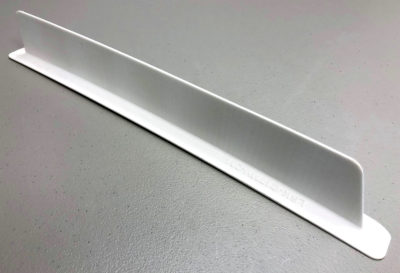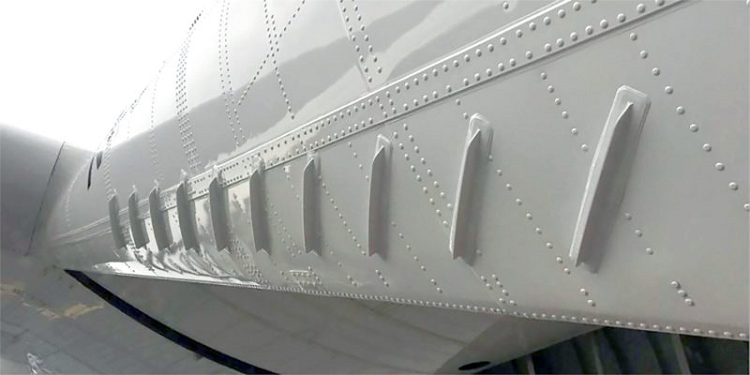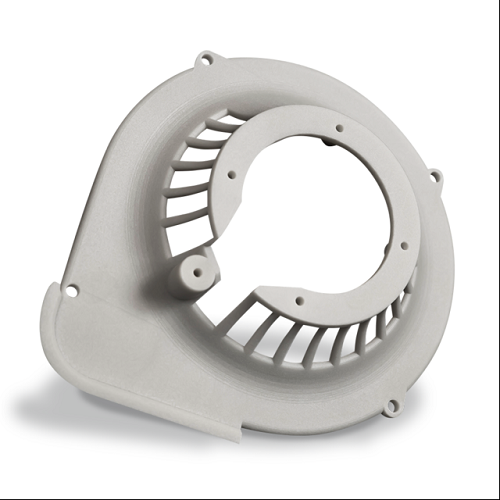Oklahoma-based defense contract parts supplier Rapid Application Group (RAG), a HUBZone and Service-Disabled Veteran-Owned Small Business (SDVOSB), recently announced a new additive manufacturing contract with Metro Aerospace, which designs, integrates, and certifies next-generation aerospace components. Headquartered in the neighboring state of Texas, Metro’s flagship product is its 3D printed microvanes, which the company states have been “proven to reduce fuel consumption” by up to 4% in civilian and military aircraft at cruise conditions, in addition to decreasing engine wear and reducing drag.
Through its new partnership with RAG, Metro Aerospace will now receive FAA-certified microvanes 3D printed with SLS technology. By using 3D printing to produce microvanes, Metro can get parts delivered on-demand, without having to pay a premium.
“From the start of this as a commercial project in 2017, additive manufacturing was an obvious choice and SLS was the best solution. For a low-volume parts business, the cost of injection molding production lines would have driven costs too high,” explained Tim Watkins, VP of Business Development for Metro Aerospace. “With SLS additive manufacturing at Rapid Application Group, we can produce parts to order at affordable cost. With such quality materials and RAG’s proven, repeatable high-quality processes, we know the parts will remain viable. We are very excited about this partnership.”
RAG, which is a member of America Makes, features over seven different kinds of AM technologies, which allows it to offer customers solutions that fit their specific needs. For Metro, which was the first company to get FAA Supplemental Type Certificate (STC) for 3D printed parts designed to be used on the exterior of an aircraft, that need is aerospace.
Founded in 2017 by a group of seasoned military and additive manufacturing specialists, RAG maintains the important certifications for, and compliance with, ISO 9001, ITAR, HUBZone, SDVOSB, and AS9100D, the latter of which is for the Aerospace, Space and Defense (AS&D) industries. Through the use of both traditional and additive manufacturing technologies, the company is known for its rapid and cost-effective provision of parts that are mission-critical in these industries.
Microvanes are small, aerodynamic components which are surface-mounted on an aircraft’s fuselage to help reshape the airflow of the tail section and in turn lower the amount of total drag on the aircraft, which then leads to lower thrust and fuel requirements, and, according to Metro, “improves flight performance and reduces fuel costs for aircraft operators.”
“Microvanes are the single most cost-effective way to improve afterbody airflow due to low upfront cost, ease of installation, and minimal aircraft downtime,” Metro states on its website. “Developed by Lockheed Martin with cooperation and support from the U.S. Air Force and rigorously tested by the U.S. Coast Guard over 10 years and 18,000 flight hours, Microvanes are proven to provide as much as 4% fuel savings during cruise conditions while also reducing engine wear. Configurations have been optimized for maximum performance while verifying no adverse impact on airdrop operations from a ramp or paratroop door.”
Patented by Lockheed Martin, Metro now holds the exclusive global license to produce, sell, and distribute microvanes, and these 3D printed parts are currently being used on cargo aircraft across five separate continents, such as different varieties of the C-130; Metro’s microvanes are also optimized for the C-17 GlobeMaster.
Metro continually works to use high-quality materials and advanced manufacturing technologies, like 3D printing, to improve the performance of aircraft. That’s why it’s partnering with RAG to use SLS technology and glass-filled materials to create and deliver FAA-certified microvanes.
Jason Dickman, COO of Rapid Application Group, stated, “Given the rigorous standards and the extreme operating conditions for the Microvanes, SLS (Selective Laser Sintering) with glass-filled materials are the only realistic choice. To meet the rigorous manufacturing requirements we qualified our sPro™ 60 HD-HS SLS platforms and Duraform® GF materials, from 3D Systems, achieving the First Article Inspection Reports (FAIR) and traceability to meet FAA regulations within weeks.”
(Source: Rapid Applications Group)
Subscribe to Our Email Newsletter
Stay up-to-date on all the latest news from the 3D printing industry and receive information and offers from third party vendors.
You May Also Like
High Stakes, High Speed: KVG Acquires 15 Nexa3D HSE 3D Printers to Boost Military Tech
As 3D printing increasingly intersects with defense and military logistics, a new partnership between Nexa3D and mission support logistics firm KVG stresses the growing importance of this technology in strategic...
3D Printer Maker EVO-tech Reborn as NEVO3D — Once More With Feeling
EVO-tech was a 3D printing service and original equipment manufacturer established in 2013 and based in Schörfling am Attersee, Austria. The company produced high-quality material extrusion systems featuring linear bearings,...
3D Printing News Briefs, March 16, 2024: Partnerships, Affordable Bioprinter, & More
We’re starting with dental 3D printing news today, and then moving on to some new partnerships. Then it’s on to some interesting university research about 3D printing plant-based pharmaceuticals, but...
FDR vs. SLA: The Right Polymer Manufacturing Choice for Your Application
The additive manufacturing (AM) industry has no shortage of acronyms when it comes to the various methodologies of industrial 3D printing. In polymer 3D printing, there are three main methods...



































